The objective of an orthodontic treatment is to create a dental occlusion responding to aesthetic and functional canons. An even harder task is to preserve the achieved results over the years. A good diagnosis, needed to set up the treatment plan and the use, after the therapy, of a fixed or removable stabilization appliance should ensure the stability of the results. It is nonetheless possible to run into dental malpositionings in subsequent years: it is not always easy to distinguish between a relapse of the treated malocclusion and the display of a tertiary crowding (1).
In case a dental crowding appears in a patient who has already undergone an orthodontic treatment, the need to operate requires to ponder some issues. It is a fact that patients do not like putting the multi-brackets appliance again, both buccally and lingually. Another aspect to take into consideration is the further financial effort they have to undertake.
To solve these problems Prof. Aldo Macchi and Dr. Nunzio Cirulli have devised the “Fixed Active Retainer” (MAC, from the Italian “Mantenitore Attivo di Contenzione”) (2,3). This device can be used both to solve relapsing dental misalignments and to perform anterior alignment therapies in patients who have never undergone this treatment. This device, simple to apply and well tolerated by the patients, has been refined over the years by its very developers in order to be used effectively to solve more complex malocclusions. For this reason, the device dealt with in this paper is called MAC 1, in order to distinguish it from its subsequent evolutions that will be dealt with in forthcoming articles.
The MAC 1 is made up of a .012 inches thick Nickel-Titanium (Ni-Ti) wire bonded with a light-polymerizing composite resin to the teeth to be moved. The use of this aid takes advantage of the possibilities offered by Ni-Ti alloys, i.e.:
– Great elastic memory and resilience, i.e. great ability to release the energy stored up in the deformation process.
– Low modification of the stress condition during deactivation so that the applied forces are more lasting and constant in time.
These were the features of the first Ni-Ti wires, that possessed “shape memory” but did not have “superelasticity” yet. “Shape memory” (4) is the ability of the material to recall its original shape after it has been deformed plastically when it is in its stabilized martensitic form (5).
Shape memory was used by the Authors for their clinical procedure while superelasticity grants the application of constant and light forces.
Clinical Procedure
The tooth, or teeth, to be moved are etched with 37% orthophosphoric acid; subsequently the adhesive is applied. Afterwards the Ni-Ti sectional is fitted to the tooth to be moved with College pliers and is bonded with fluid composite. On the adjacent tooth, used as anchorage, the sectional is cut with a bur in order to remove excess wire. It can be necessary to reduce interproximal enamel (stripping) to regain some space in the arch.
Fixed Active Retainer (M.A.C.)
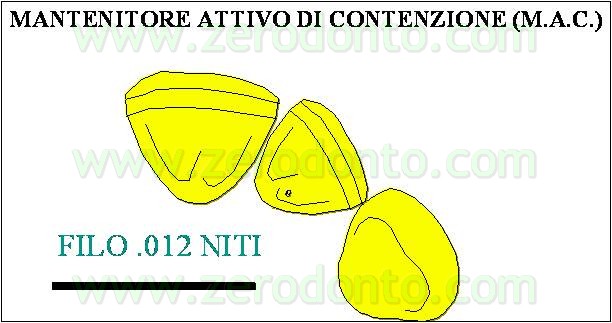
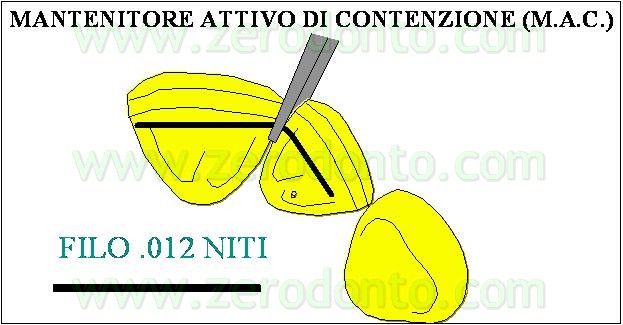

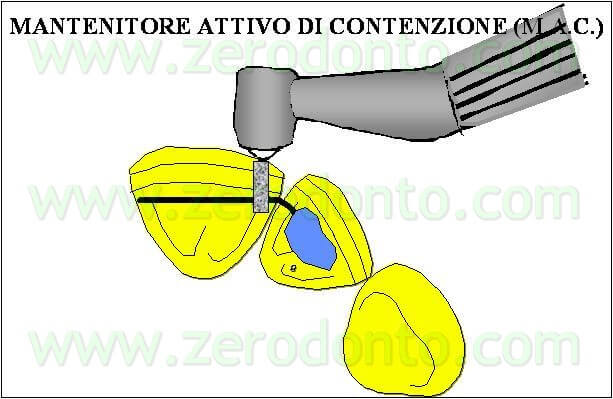
The system of forces that takes place determines the development of a single force (F) on the anchorage tooth and of a momentum (M) on the tooth where the wire is fixed with the composite.
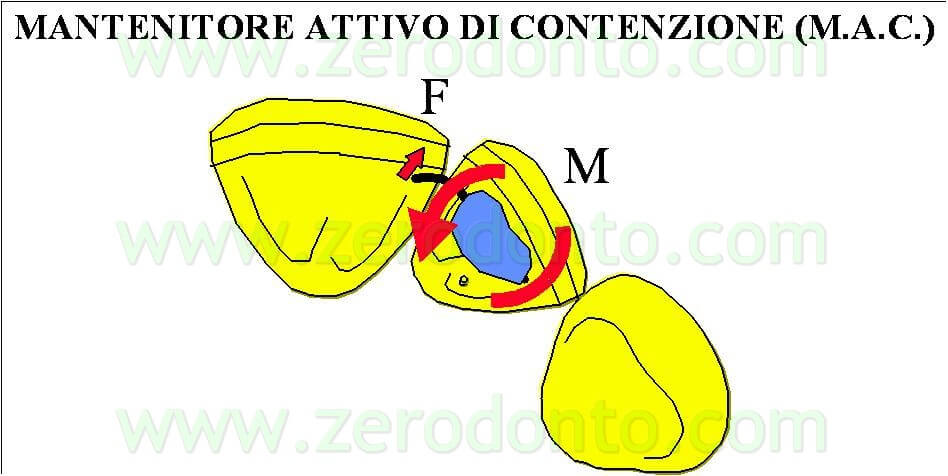
The fulcrum or “articulation” of this system is the point where the wire undergoes maximum bending. At this level the outer surface of the wire undergoes a transformation from austenite (state in which shape memory is at its maximum) to martensite (state in which superelasticity is at its maximum). According to the Authors’ experience the single force is so light as not to cause significant movements, while the momentum always causes the desired movement on the malpositioned tooth. Moreover as the malpositioned element achieves the desired alignment the lever arm increases, increasing, on its turn, the momentum arm on the tooth itself.
When the alignment is finally achieved the “articulation” of the sectional disappears and the alloy returns to its austenitic phase. In this phase it exerts its shape memory at its best and works as a perfect stabilization aid.
Clinical cases
First case
To solve the misalignment of the 12 a .012 inches Ni-Ti sectional is bonded on the 12 and anchored on the 11. Subsequently another sectional was put between the 21 and the 22 to align the central and left lateral as well. The same sectionals were used as stabilizers after the alignment, achieved in about 3 month, was complete.
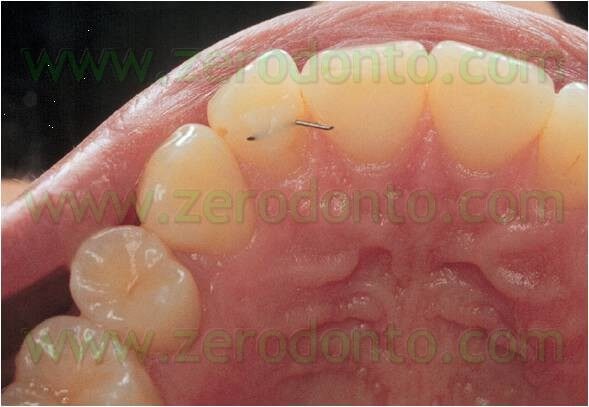

Second case
To solve the misalignment of the 21-22 a .012 inches Ni-Ti sectional was bonded on the 21 and anchored on the 22. The same sectional was used as a stabilizer after the alignment, achieved in about 3 month, was complete.

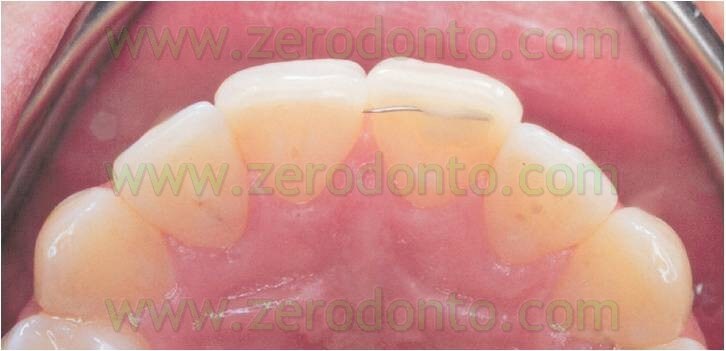
Third case
To solve the misalignment of the 11-21 a .012 inches Ni-Ti sectional was bonded on the 21 and anchored on the 11. The same sectional was used as stabilizer after the alignment, achieved in about 3 month, was complete.
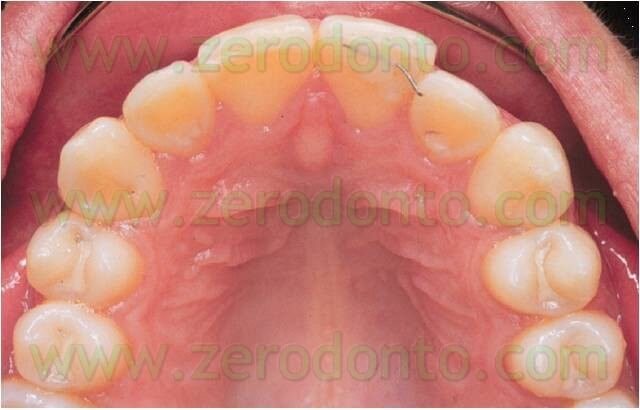
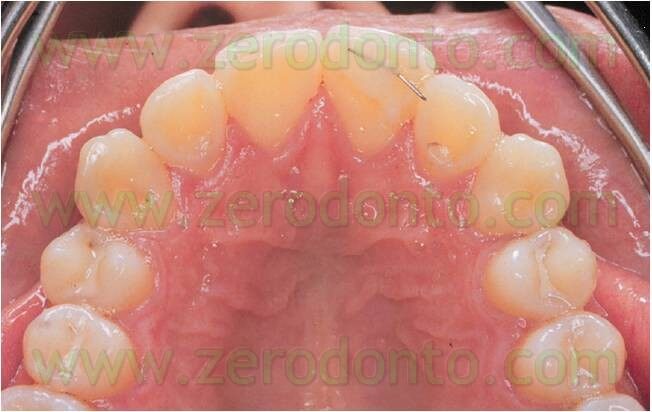
Conclusions
The Fixed Active Retainer 1 (MAC 1) is the first fixed active retainer ever made (2,3). This device, devised by Prof. Aldo Macchi and Dr. Nunzio Cirulli, has been used since 1996. It is easy to be made and low in cost: it makes it possible to solve anterior misalignments of little importance. It can be used at any age and is well tolerated by the patients, turning out to be more comfortable than lingual brackets (6,7) and completely invisible compared to buccal brackets.
In order to solve more severe dental malpositionings Prof. Aldo Macchi has developed, over the years, more complex and sophisticated devices. These devices, constituting an evolution of MAC 1 to reach MAC 4, will be dealt with in forthcoming articles.
Bibliography
1. F Van der Linden: Theoretical and practical aspects of crowding in the human dentition. J.A.D.A. 89: 139- 153, 1974.
2. A Macchi, S Rania, N Cirulli. Una proposta per la gestione dei disallineamenti anteriori: il Mantenitore Attivo di Contenzione (MAC). Mondo Ortodontico 5:389-393, 1999.
3. A Macchi, N Cirulli. Fixed Active Retainer for Minor Anterior Tooth Movement. J Clin Orthod 34:48-49, 2000.
4. G Sander. Festigkeit und elastizitat kieferorthopadisher drahte unter berucksichtgung der superelastischen materialen. In: Informationen aus der orthodontie und kieferorthopadie. Huthing P.Heidelberg.
5. GF Andreasen . A clinical trial of alignment of teeth using a 0.019 inch thermal nitinol wire with a transition temperature range between 31 and 45 degrees. Am J Orthod 78:528-37, 1978.
6. Miyawakaki, M Yasuhara, Y Koh. Discomfort caused by bonded orthodontic appliances in adult patients examined by retrospective questionnaire. Am J Orthod. 115:83-88, 1999.
7. PM Sinclair, MF Cannito, LJ Goates, LF Solomos, CM Alexander. Patient responses to lingual appliances. J Clin Orthod 20:396-404, 1986.
Prof. Aldo Macchi
Surgeon
Specialist in Odontostomatology
Specialist in Orthognathodontics
Director of the Odontostomatology Clinic of the University of Insubria – Varese
Professor (Med. 28) at the University of Insubria where he teaches Dental Materials and Prosthetic Technology in the Dentistry and Prosthesis Degree Course. He is Appointed Professor of Biomechanics – that he teaches at the Orthognathodontics Specialization School – University of Insubria.
He has written over 108 scientific papers in Orthognathodontics, Odontostomatologic Surgery, Dental Materials and Computerized Medicine: many of these publications deal with Orthodontic Biomechanics and the Lingual Orthodontic Technique. He has held numerous courses and seminars in Orthodontics in various Universities in Italy and abroad.
E-mail aldo.macchi@uninsubria.it
Dr. Nunzio Cirulli
Specialized in Orthognathodontics
Ph.D. in Ortho-phono-rhino-stomato-gnathodontics at the University of Bari.
Contract Professor at the University of l’Aquila and at the University of Santiago de Compostela – Spain.
Spokesman, with clinical and research works, in numerous national and international conferences.
Author of publications and translations on specialized national and international magazines.
He has held courses of Orthodontic in various Universities in Italy (Rome La Cattolica, Turin, Genoa, Varese, Messina) and abroad (Madrid, Barcelona, Valencia).
He is Ordinary Member of the Italian Orthodontic Society, of the European Society of Lingual Orthodontics, of the European Orthodontic Society and of the World Federation of Orthodontists.
For information:
info@studiocirulli.it
zerodonto@gmail.com

